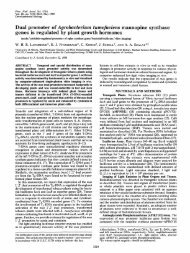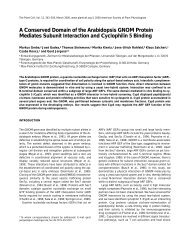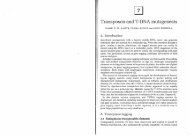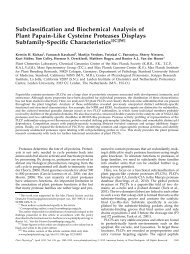Plasma membrane calcium ATPases are important components of ...
Plasma membrane calcium ATPases are important components of ...
Plasma membrane calcium ATPases are important components of ...
Create successful ePaper yourself
Turn your PDF publications into a flip-book with our unique Google optimized e-Paper software.
Frei dit Frey et al.12345678910111213141516171819202122232425262728293031323334influx in the double mutant demonstrates that ACA8 and ACA10 both contribute to the flg22-elicited Ca 2+ burst and indicates a role for these proteins in the regulation <strong>of</strong> FLS2-mediatedearly responses.Production <strong>of</strong> ROS upon MAMP treatments is mediated by plasma <strong>membrane</strong>residentNADPH oxidases, which depend on Ca 2+ signalling for their function (Kobayashi etal., 2007; Mersmann et al., 2010). We examined the flg22-triggered oxidative burst anddetected no significant differences between wild-type plants and the aca8 and aca10 singlemutants, while the aca8 aca10 double mutant displayed an overall decreased ROS productionwhen treated with flg22 (Figure 3B). ROS production upon chitin treatment remainedcomparable to wild type in all tested mutants. The decrease in oxidative burst correlated withthe reduced flg22-triggered Ca 2+ signature in aca8 aca10 plants, which is in agreement withCa 2+ operating upstream <strong>of</strong> ROS production. When monitoring these individual MAMPresponses we observed genetic redundancy between ACA8 and ACA10 suggesting that bothCa 2+ <strong>ATPases</strong> exert overlapping functions in these early and transient flg22 responses, whichis in contrast to the unequal role <strong>of</strong> ACA8 and ACA10 in development. Western blot analysisrevealed unaltered FLS2 protein accumulation in the aca mutants comp<strong>are</strong>d to wild typeplants (Figure 3C). Therefore the observed reduction in flg22-triggered Ca 2+ and ROS burstsis likely caused by loss-<strong>of</strong>-ACA8 and -ACA10 function rather than altered FLS2 levels.ACA8 and ACA10 <strong>are</strong> required for proper flg22-induced transcriptional changesFor more detailed analysis <strong>of</strong> ACA8/ACA10 functions, we determined thetranscriptional changes caused by ACA8 ACA10 loss-<strong>of</strong>-function by microarray analysis. Atotal <strong>of</strong> 69 transcripts were identified as showing significantly elevated transcript levels andten had significantly lower transcript abundance in the aca8 aca10 double mutant comp<strong>are</strong>dto wild type seedlings (Table S2). We validated differential transcript accumulation <strong>of</strong> 19 out<strong>of</strong> 20 tested genes by quantitative RT-PCR analysis, <strong>of</strong> which 17 showed wild type-likeexpression in the aca8 aca10/35S::ACA8-GFP line, further substantiating functionality <strong>of</strong> theACA8-GFP fusion protein (Table S2). Most remarkably, genes belonging to the GOcategories "<strong>calcium</strong> ion binding" and "cation binding" were overrepresented among the genesthat show higher transcript levels in the aca8 aca10 double mutant (Table S2). The firstcategory includes genes coding for CaM-like proteins such as CML35, CML36, CML41,CML45, CML46, CML47 (McCormack et al., 2005). Increased expression <strong>of</strong> CaM-like genescould be a compensatory mechanism to counteract the deficiency in extruding Ca 2+ ions fromthe cytosol in aca8 aca10 plants.8






